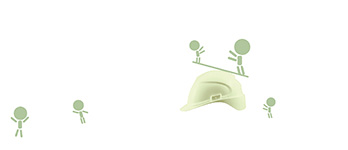 |
Annual report 2006 JSC "TGC-1" |
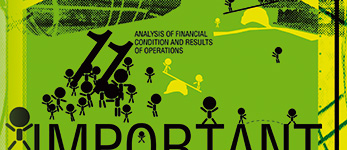 |
11. ANALYSIS OF FINANCIAL CONDITION AND RESULTS OF OPERATIONS
11.1. KEY POINTS OF ACCOUNTING POLICY
TGC-1 accounting policy is a set of principles, procedures and methodologies governing the administration of accounting, designed to make sure the Company’s accounting records and financial statements, provide complete, unbiased and objective financial and management information sensitive to the corporate and industrial peculiarities of the Company’s business.
TGC-1 keeps its accounting records in accordance with the Federal Accounting Act No. 129-FZ of November 21, 1996; the Bylaw of Accounting and Reporting in the Russian Federation, enacted by Directive No. 34n of the Russian Ministry of Finance dated July 29, 1998; and the Chart of Accounts, deriving from the Chart of Accounts for Purposes of Financial Accounting and its enclosed User Guide, both enacted by the Russian Ministry of Finance in its Directive No. 94n of October 31, 2000. The Company is also guided by a number of industry-related and corporate peculiarities, described in Order № 855, issued by RAO “UES of Russia” on December 30, 2005 Re: Accounting Policy at RAO “UES of Russia” for the Year 2006.
The Company maintains its financial and tax accounting for property (with the exception of fixed assets), liabilities and business transactions in Russian rubles and kopecks, without rounding. Fixed assets are accounted for in rubles. Any difference is posted to financial profit/loss. For the purposes of financial and tax accounting, the value of any assets or liabilities denominated in a foreign currency is converted into rubles as required by the Russian Accounting Standards (RAS) 3/2000.
Inventories of property and liabilities are taken in accordance with the Methodology Guide for Inventories of Property and Financial Liabilities, enacted by the Finance Ministry of Russia in its Order No. 49 of June 13, 1995.
The Company’s 2006 financial statements, prepared in accordance with the Russian Accounting Standards, include a balance sheet, income statement, statement of equity change, cash flow statement, and an appendix to the balance sheet. Under Russian Accounting Standards, the fiscal (reporting) year for all companies set down in Russia equals the calendar year, ending on December 31.
Financial statements are generated by the Company’s Central Accounting Office, which draws on consolidated records of assets, liabilities and financial results, as well as the information filed by each individual division. After the Company’s annual financial statements are reviewed and ratified by its Annual General Meeting, they are filed with the appropriate bodies according to the timeline established by Art. 15 of the Federal Accounting Act No. 129-FZ of November 21, 1996. The Company publishes its approved financial reporting no later than June 1 of the year following the year reported.
Fixed assets accounting
Fixed assets include assets used in production and provision of services, including services rendered to meet the management needs of TGC-1, for a period exceeding 12 months.
Fixed assets are recorded at their initial cost. The costs of any material upgrades or improvements are charged to the asset’s value added. Interest on loans is capitalized. The costs of maintenance and minor repairs are charged to production costs as they arise. Depreciation on fixed assets is done in a straight-line method based on the use period of these objects.
Accounts receivable and advances paid
Records for accounts receivable are entered inclusive of value added tax, for which the Company files after the receivable is collected. Money owing from customers and other groups of accounts receivable is adjusted by the amount of reserve, created to cover debt depreciation. The Company creates this doubtful debt cover reserve when it receives sufficient evidence that it may not be able to collect all the receivables outstanding as initially contracted.
Value added tax
VAT applied on sales is payable to taxation authorities as payments for provided services. Incoming VAT is set off against the VAT charged on sales proceeds, as is paid by suppliers.
Accounts payable and Charges
Accounts payable to suppliers and other creditors are entered as per primary instruments accepted for accounting purposes, and the amounts of liabilities incurred as they appear in the payment instruments. Accounts payable on non-invoiced deliveries are recorded as “incoming value”, based on their price and contractual terms.
Inventories
The Company accounts for its inventories in accordance with the Accounting Policy on Inventories (RAS 5/01), enacted by the Russian Finance Ministry in its Order No.44n of September 9, 2001.
Profit allocation
TGC-1 Annual General Meeting decides on how the Company will use any profit remaining after profits tax and other statutory taxes and charges, including penalties for any filing irregularities.
11.2. АНАЛИЗ ФИНАНСОВЫХ РЕЗУЛЬТАТОВ
JSC “TGC-1” began its operating activity on October 1, 2005, so, in effect, the Company’s 2005 reporting only covered 4th Quarter 2005, and it would not be appropriate to compare its 2006 and 2005 financials.

Sales
TGC-1 sales as of the end of the year 2006 totaled RUR 20,502.7 million. These sales were mostly reached by heat sales (44.64%), electricity sales to domestic consumers (42.28%), and electricity (power) sales at new wholesale electricity and power market (NOREM). The item of other products, works and services of an industrial nature made 2.70% in cost structure, electricity export – 1.59%.
Cost
The cost of goods sold in 2006 totaled RUR 20,177.4 million. The largest shares in electricity and heat cost structure made fuel costs (43%), production services (13%), salaries and social charges (12%), and lease costs (9%).
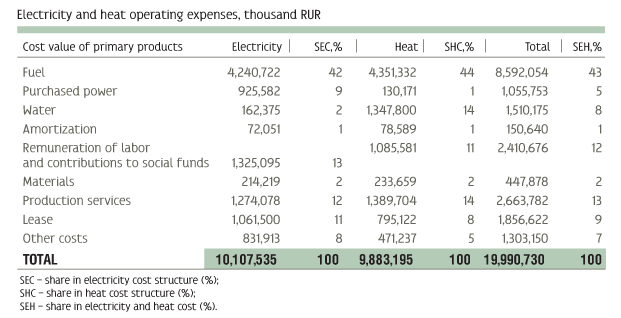
Profit
TGC-1 sales profit as of the end of the year 2006 totaled RUR 325.3 million, pre-tax profit — RUR 726.4 million. The total sum of profit tax and other similar mandatory payments made RUR 128.2 thousand. TGC-1 net profit totaled
RUR 598.2 million.
Distribution of Profit
Forecasted distribution of TGC-1 profit of 2006:
- RUR 300,000 thousand are expected to be allocated for dividend payments;
- Reserve fund – RUR 29,908 thousand (the Company is forming a Reserve Fund to the amount of 5% of the authorized capital);
- RUR 268,250 thousand will remain in the turnover of the Company to ensure production development and other similar arrangements for purchasing (creating) new tangibles or forming other assets.
11.3. ANALYSIS OF FINANCIAL CONDITION
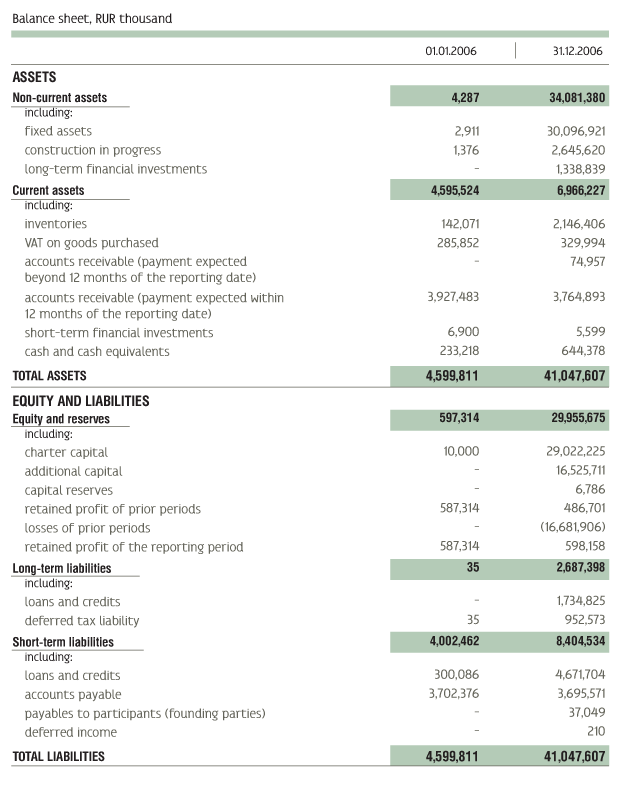
Non-current Assets
The total balance at 31.12.2006 made RUR 41,047.6 million. 73% of the Company’s non-current assets totaling RUR 34,081.4 million at the end of 2006 are represented by fixed assets (RUR 30,096.9 million). As compared with the year 2005 fixed assets increased by RUR 30,094.0 million due to entering in TGC-1 balance-sheet of non-current assets of joined generating companies being earlier itemized by lease scheme at off-balance accounts. The value of construction in progress at Company’s balance sheet reached RUR 2,645.6 million while increasing by RUR 2,644 million as compared with the beginning of the year; long-term financial investments made RUR 1,338.8 million.
Current Assets
Current assets of the Company totaled RUR 6,966 million or 17% of total assets as of the end of 2006. The sum of current assets increased by 51.6% as compared with the beginning of the year due to Company’s inventories increase by RUR 2,004 million (more than 15 times higher). Short-term accounts receivable decreased by RUR 162,590 thousand (4.1%) and made RUR 3,764.9 million; long-term accounts receivable totaled RUR 74,957 thousand. Short-term financial investments reduced by 18.9%, the rest of cash and cash equivalents increased
by RUR 411 million and made RUR 644 million. The total share of accounts receivable totaled 55.1% of Company’s current assets as of the end of 2006.
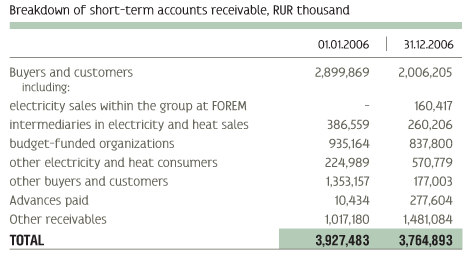
Company’s net assets totaled RUR 29,955.9 million as of December 31, 2006. It represents the cost estimate of Company’s assets after formal or actual satisfaction of third parties’ requirements. Thus, the amount of net assets represents the part of Company’s assets value, which might be allocated among the owners of the Company in case of its liquidation. TGC-1 charter capital totaled RUR 29,022.2 million, and it is smaller than the amount of Company’s net assets. It complies with the art. 35 of the “Stock companies” Act and defines the Company as confident player at derivatives market.
Capital and reserves
As compared with the year 2005 the shareholder equity increased by RUR 29,358.4 million and made 73% of the total balance. This significant increase results from the Company’s reorganization: joining generating companies of St. Petersburg, Leningrad and Murmansk Regions, and the Republic of Karelia to JSC “TGC-1”. Retained profit of the reporting period as of the end of the year totaled RUR 598.2 million, losses of prior periods – RUR 16,681.9 million.
Liabilities
Long-term loans and credits made at the end of the year RUR 1,734.8 million, deferred tax liability — RUR 952.6 million. TGC-1 total long-term liabilities constituted RUR 2,687.4 million.
Most of the loans are short-term bank credits — RUR 4,671.7 million (55.6% of Company’s total short-term liabilities, which made RUR 8,404.5 million).
Company’s accounts payable in 2006 totaled RUR 3,695.6 million, including 53.5% or RUR 1,976.8 million of accounts payable to suppliers and contractors, 32.2% or RUR 1,189.97 million of advances received. During the year, accounts payable to suppliers and contractors increased by RUR 527.9 million, whereas the advances received increased by RUR 601.8 million.
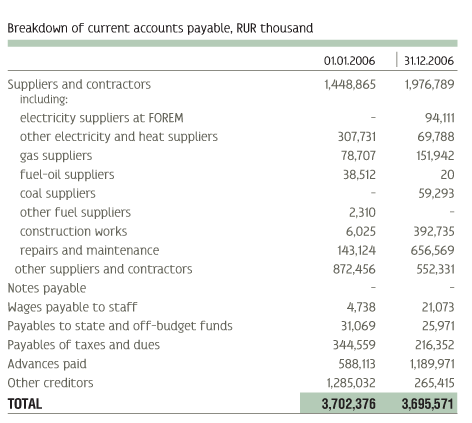
Accounts payable to participants (founding parties) made at the end of the year 2006 RUR 37,049 thousand, deferred income – RUR 210 thousand.
Liquidity analysis
The Company uses the following ratios to describe its liquidity and solvency level:
- Absolute Liquidity Ratio;
- Quick Liquidity Ratio;
- Current Liquidity Ratio;
- Equity Ratio;
- Inventories Cover Ratio.
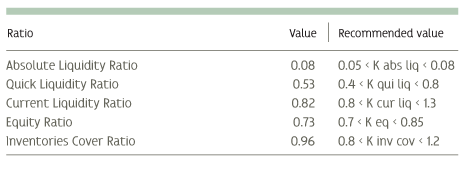
The Absolute Liquidity Ratio (ALR) describes whether the company is able to repay its liabilities early. The Company had an ALR of 0.08% at the end of 2006, meaning that its available highly liquid assets sufficiently cover its current liabilities.
Quick Liquidity Ratio (QLR) describes whether the company is able to repay its current liabilities with its most liquid assets. The Company’s QLR was 0.53, well within the recommended bracket.
Current Liquidity Ratio (CLR) shows whether the current assets (excluding payment expected beyond 12 months of the reporting date) available to the Company are sufficient to cover its short-term liabilities. This index describes the Company’s ability to face out fast market changes, e.g. payment delays by customers, unforeseen expenses, or early debt requirement. As of December 31, 2006, the Company’s CLR was 0.82, well below the regulation cap for energy utilities.
Equity Ratio (0.73) shows that debt makes up an insignificant share of the Company’s liabilities (27%). Long-term debt also makes up a small percentage of the Company’s liabilities: 7%, or RUR 2,688,913 thousand.
Inventories Cover Ratio (ICR) is the ratio of the bottom lines for “Long-Term Liabilities” and “Short-Term Liabilities” less deferred revenue, to “Current Assets”. This index shows whether the sources of financing available to the Company are sufficient to cover the assets being financed. The Company’s ICR was 0.96 for the period reported, meaning that the Company has access to sufficient liabilities to cover its current assets.
Profitability analysis

Return on Sales indicates profit per one ruble of sales. TGC-1 made 2 kopecks per every ruble on products sold during the period reported.
Return on Business reflects profit per one ruble of costs. The value in the table above means the Company made 1.61 kopecks profit per every cost ruble.
Return on Total Assets (ROTA) is the ratio between profit before tax and total assets, showing whether all assets on the balance sheet were used efficiently. The value above means that the Company made 1.77 kopecks net profit per
1 ruble of its total assets.
Return on Equity (ROE) is the ratio of net profit to equity, indicating whether the equity was used well. The Company showed a ROE of 2% for the period reported, meaning that it made 2 kopecks net profit per every ruble invested by its shareholders.
